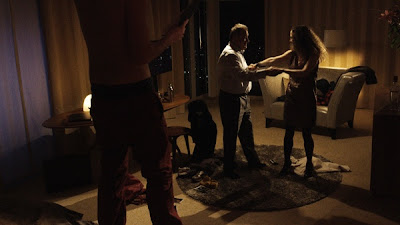 |
| Edvard Munch Symbolsk studie / Symbolic Study, 1893 1894, Tempera on unprimed cardboard Munch Museum Munch-Ellingsen Group BONO, Oslo 2013 Photo Munch Museum, Oslo |
This year I decided to dedicate the month of August to visit exhibitions that I was intrigued by the subject matter. After visiting the exhibition “When Attitudes Become Form: Bern 1969/Venice 2013”, on display at the Headquarters of the Prada Foundation in Venice, I was fascinated by the title of the exhibition of the Fondazione Bevilacqua La Masa, and that from the articles that I read promised viewing works just notes Munch. “Beware of the Holy Whore: Edvard Munch and the Dilemma of Emancipation” is a project organised by the Office for Contemporary Art Norway and Fondazione Bevilacqua La Masa in Venice, as the official Norwegian representation at the 55th International Art Exhibition. The exhibition includes a serie of rarely exhibited works by Edvard Munch in addition to a newly commissioned film by Lene Berg, “Ung Løs Gris” (Dirty Young Loose 2013), and revolves around emancipation an issue Always vexed with contradiction, between the realm of freedom and consequences of the isolation that often accompany the pursue of a different life.
Quest’anno ho deciso di dedicare il mese di agosto alla visita di mostre che mi incuriosivano per il tema trattato. Dopo aver visitato la mostra “When Attitudes Become Form: Bern 1969/Venice 2013” esposta presso la sede veneziana della Fondazione Prada, ero attratta dal titolo della mostra della Fondazione Bevilacqua La Masa e che dagli articoli che avevo letto prometteva la visione di opere poco note di Munch. “Attenzione alla Puttana Santa: Edvard Munch e il dilemma dell’emancipazione” è un progetto organizzato dall’Office for Contemporary Art Norway e la Fondazione Bevilacqua La Masa di Venezia, come contributo ufficiale della Norvegia alla 55° Esposizione Internazionale d’Arte. La mostra comprende una serie di opere di Edvard Munch che di rado sono state esposte oltre a un film di recente commissionato da Lene Berg, “Ung Løs Gris” (Sudicio Giovane Facile 2013), e che ruota intorno all’idea di emancipazione come prospettiva contraddittoria, sospesa tra lo spazio della libertà e le conseguenze di quell’isolamento che spesso accompagna la ricerca di una vita diversa.


The exhibition begins with the film by Lene Berg “Ung Løs Gris” (Dirty Young Loose 2013), a film that concentrates on three characters who are interrogated about their roles as either victims or perpetrators in a complex situation. The film explores the interpretation of human behaviour based on preconceptions about roles and norms. Just like the exhibition as a whole, the film presents the deconstruction of an original scene which functions as a catalyst for a revision of the politics of liberation, of gender struggle and of internal conflict, the dilemma of emancipation.
La mostra inizia proprio con il film di Lene Berg “Ung Løs Gris” (sudicio Giovane Facile 2013), che si concentra su tre personaggi stereotipati, a cui vengono poste domande sui loro ruoli di vittime o carnefici in una situazione complessa. Il film analizza l’interpretazione del comportamento umano sulla base dei pregiudizi e delle regole dominanti. Come la mostra nel suo complesso, il film presenta la decostruzione di una scena originale, la quale funziona da catalizzatore per la riconsiderazione delle politiche di liberazione, del conflitto di genere e del conflitto interiore: ovvero il dilemma dell’emancipazione.
 |
| “Ung Løs Gris” (Dirty Young Loose 2013), |
 |
| “Ung Løs Gris” (Dirty Young Loose 2013), |
The exhibition continues with works by Munch. Munch’s emphatic treatment of these themes from 1902 to 1908, before entering the asylum, reflected an internal ambiguity and anguish. Munch described this period as an ‘eternal civil war’, after which his work moved to a more distanced treatment of subjects, in social caricatures in which he offers an ironic critique of an increasingly capitalist and permissive society.
La mostra prosegue con le opere di Munch. L’enfasi con cui Munc
h trattò questi temi dal 1902 al 1908, prima del ricovero in un istituto psichiatrico, evoca angoscia e ambiguità interiore. Munch ha descritto quel periodo come “un’eterna guerra civile”, al termine del quale il suo lavoro fu caratterizzato da una maggiore distanza dai soggetti trattati, con caricature in cui è presente una critica ironica a una società sempre più capitalistica e permissiva.
 |
| Edvard Munch Selvportrett i sengen / Selfportrait in Bed, c. 1902 |
 |
| Edvard Munch Selvportrett ved lunsjbordet pa Dr. Jacobsons klinikk / Selfportrait at the Lunchtable at Dr. Jacobson’s clinic, 1908–09 |












